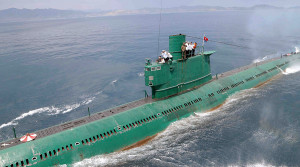
According to Lee Byoung-ho, Director of the Intelligence Agency of the Republic of South Korea, fragments of the safety cover of the missile that usually appear at launches were found on the surface of the Sea of Japan (the East Sea) in the Wonsan area on November 28. It was reported that Kim Jong-un was personally watching the launch, but the missile had never appeared in the air. That led South Korean military experts to assume that the attempt to launch a missile had failed.
The speculations about the faulty launch were immediately supported with suggestions that the SLBMs are extremely dangerous since they cannot be detected until actually launched (as if it were something unheard of before) and that it was the second test the North had conducted since May of this year. Back then, Kim Jong-un was indeed personally present at the missile launch site. Reportedly that was the reason for his absence from the Moscow May 9 celebration.
North Koreans published photos of the missile launch claiming that it was successful. Some experts, however, question the photos saying that they were likely modified. In their opinion, North Koreans launched a blank, which could but only rise above the water level and fly only 100-150 meters. They also speculate that missile was launched not from a submarine, but from a specially designed test rig.
Other experts were even more skeptical: fragments found on the water surface were not pieces of the safety cover of an SLBM, but “some other parts.” Yet others believe that Pyongyang conducted a test-launch of a missile capsule only. When a missile is fired, first, the capsule is ejected from the water to the air, then the capsule safety cover separates, rocket engines ignite and only then the actual flight of the missile begins. Thus, there are no reasons to stigmatize the test-launch as a failure: it is logical to first master ejection of the missile capsule and only then launch the actual missile. Keeping in mind troubles Russian military personnel experienced when testing Bulava, it should be understood that this is quite a serious issue.
Anyway, expert conclusions did contain some regular share of alarmism: In 2-3 years from now, North Korean armed forces will have a missile-firing submarine, which means South Korea must work out some symmetrical measures to maintain the balance of powers. By today, though, the South Korean Ministry of Defense has gone only as far as to accuse North Korea of another violation of the resolution of the United Nations Security Council prohibiting launches of ballistic missiles.
How can this situation be assessed? Since underwater launches are technologically complex, many are skeptical about North Korea’s abilities to implement them. If North Koreans indeed managed to conduct a submarine-launched ballistic missile test, that means they had found solutions to a number of technical problems, for example, the issue of stable fuel. This can be considered a breakthrough, but it should not be overlooked that before the last test the North Korean missile program was just a little over ten years old and that only approximately four launches (where only one or two were successful) have been conducted as part of it. These background data, however, are not sufficient to reason that North Koreans indeed have a decent missile. At any rate (and please, correct me if I am mistaken), a minimum of ten-twelve successful launches were required in the Soviet Union to conclude that the new type of missile actually worked. Then there is still another issue that should be considered: whether North Koreans tested just one experimental missile, or whether they have necessary facilities to launch a mass production of them.
Here we have to analyze two important aspects. Point one. North Korea has just demonstrated that it has high-tech weapons and regardless of how many such missile-firing submarines Pyongyang actually has, those wishing to wedge “the second Korean war” would have to account for this factor in their plans. In this context, North Korean weapon plays the role of the means of strategic deterrence.
Point two. The formal result of the latest testing is the launching of a military missile. If earlier launches of North Korean satellites could have been interpreted as a program of a peaceful exploration of the outer space, and many observers, including the author of this article, believed that in this context imposition of sanctions on Pyongyang was unjustified, the latest undisguised military preparations could provoke a more straightforward reaction.
Had that happened at a different point in history, I would expect that the democratic sector would respond with another fairly strong fit of hysteria and would accuse North Korea of posing even greater threat to the global security. I would also expect that eventually there would be respective discussions in the UN Security Council with possible subsequent adoption of new resolutions and sanctions. However, current crisis in Ukraine and actions of ISIS have somewhat altered the perception of what a “threat to the global security” really is. And at this point it would be quite reasonable to just wait and see what the reaction to the latest missile launch test will be like.
Konstantin Asmolov, Ph.D, Chief Research Fellow of the Center for Korean Studies, Institute of Far Eastern Studies, Russian Academy of Sciences, exclusively for the online magazine “New Eastern Outlook”.
